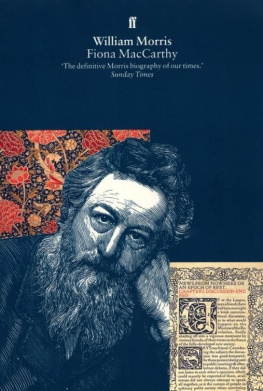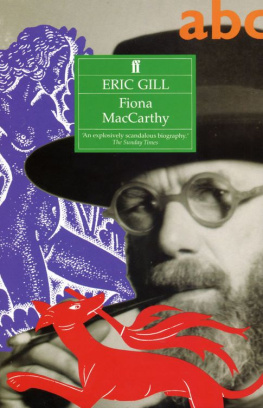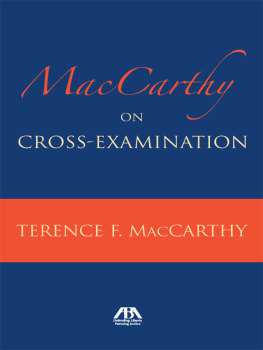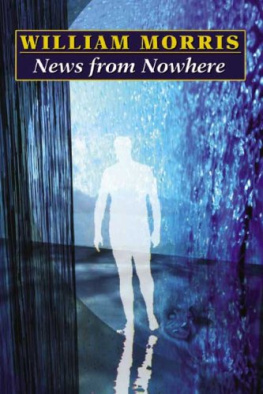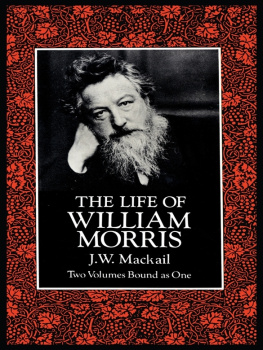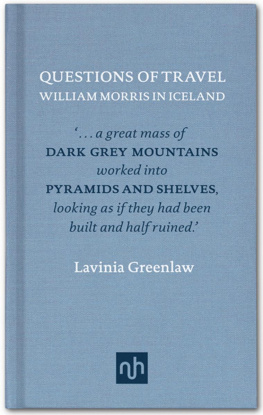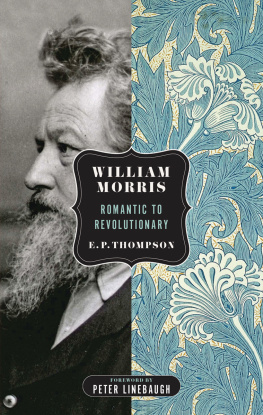When Morris was dying one of his physicians diagnosed his disease as simply being William Morris, and having done more work than most ten men. Morris was one of the best-known and most prolific Victorian poets. He was the greatest artist-craftsman of his period. He ran a successful decorating and manufacturing business and he kept a high-profile central London retail shop. Morris was also a passionate social reformer, an early environmentalist, an educationalist and would-be feminist; at the age of fifty he crossed the river of fire to become a revolutionary Socialist. There is something almost suspect in this sheer range of activity. In an age of ever-narrowing specialization Morriss versatility is difficult to grasp.
Over the past five years of research on this biography my aim has been to reclaim Morris in the detail of his idiosyncrasy and strangeness as he appeared to his contemporaries and to argue that his highly original, painfully heroic progress through life impinges on us still, from old Socialists to new conservationists. His largeness of vision is the key to it. Morris was his own emblem of wholeness. He wanted to integrate the city with the country, the present with the past, the public and the personal moralities. Most of all he was concerned with proper human occupation, whether going under the name of work or play. In the late twentieth century throughout the West this is our urgent problem. Technological advance has made ordinary skill and modest pride in work redundant. But redundancy of people brings the threat of disconnection from life.
Morris knew a great deal but stayed peculiarly innocent. People noted how even in old age he looked like a large child. If my book dwells on Morriss childhood this is conscious, since the memories of childhood permeate his later visions, creeping through his letters, edging out into his poetry. His Utopian novel, NewsfromNowhere, is a shimmeringly hopeful and a very childlike book. Morris kept his mind open to a different sort of future. His oddness, and importance, lies in this disengagement from contemporary structures. Like the child on the beach he could knock down the whole sandcastle, envisaging a finer one erected in its place.
Even to his contemporaries Morris seemed peculiar. Victorian memoirs overflow with references to his rum and indescribable deportment, his tempestuous and exacting company, his disconcerting habit of pacing up and down a room like a caged lion to work off his superabundant energy. Beg Pardon, Sir, were you ever Captain of the SeaSwallow? asked a fireman, accosting him in a street in Kensington. I was not, replied Morris. But in his robust blue seamans jacket, with his rollicking gait, he could quite well have been.
Recent books about Morris have tended to take specialist views of him. We have had the Marxist Morris, the Jungian Morris, the Freudian Morris. He has now been appropriated by the Greens. The layers of theory have obscured his whole personality. I hope to reverse this process, to unwrap him and describe him and, if possible, to penetrate a little of his mystery in a way that no one has attempted since J. W. Mackail, Morriss first biographer, whose fine two-volume LifeofWilliamMorris was published in 1899. If I have not managed to recapture Morriss strange vigour, his talent for bracing the nerves of the flaccid, his extraordinary veerings from Nordic stoicism to an almost female tenderness, his ebbs and flows from rampageousness to sweetness, then this book will be no good.
Morris had a sense of place so acute as to be almost a disability. Places clung to him. When one of his places was endangered, in the sense of being demolished or crassly redeveloped, he felt it as a human grief. Much of the research for this biography has taken the form of voyages around the places where Morris lived and worked and travelled. Readers may find it eccentric that I have listed places in my sources, but I have found them as crucial as literary sources, often more so. There is no real way of understanding Morris until you can see, almost with his eyes, the particular pattern of a landscape, the relationship of buildings, the precise lie of the land. Without tramping around Kelmscott, finding the hidden churches that so delighted Morris, the glimpses of the river, the mediaeval barns, it would be difficult to comprehend the hold that Kelmscott had on him. Without retracing his journeys around Northern France and Iceland it would be hardly possible to see how the places he returned to, in his imagination, lasted all his life.
Morris had a deep attachment to things, and a huge reservoir of knowledge of their history. The Bodleian Library in Oxford as well as the then South Kensington Museum deferred to his judgement. He was in the great tradition of the Victorian connoisseur. But unlike most connoisseurs he was himself a maker. With an almost manic industriousness Morris set out to rediscover lost techniques for fabricating, in succession: embroidery; stained glass; illumination and calligraphy; textile dyeing, printing and weaving; high-warp tapestry. The last few years of his life were spent in reviving hand-printing at his own Kelmscott Press. Morriss objects, like his places, have loomed large in my sources. I have tried to steep myself in his own sense of tangibility, scrutinizing, stroking when permitted by their owners the things that Morris made. I began by imagining, as most people imagine, his wallpapers and chintzes as the peak of his achievement, together with the most spectacular of the Kelmscott Press editions. After searching out his less accessible artefacts (my notebooks bulge with details of over a hundred visits) I believe the glorious sequence of Morris & Co. stained-glass windows surpasses the rest. It is the logical development of Pre-Raphaelite painting, vividly pictorial, art beyond the easel, telling stories, conveying information even to the Victorian illiterate.
Words too poured out of Morris. There was a neurotic basis to his fluency. On a good day he could write 1,000 lines of verse. (Most serious writers are content with 1,000 words of prose.) After his death his work was assembled into twenty-four volumes, an act of devotion by his second daughter May. He is seldom read these days, outside anthologies. I believe this is mistaken. I would not press the claims of Morriss own favourite SigurdtheVolsung; it is too large, too chant-like. Volsungs are out of fashion. Sigurd sounds as if composed in transit, and may well have been; Morris frequently wrote verse on trains between engagements or on the swaying seat of a London omnibus. But there is much to reward the modern reader in Morriss early poems, TheDefenceof Guenevere, short, spare, edgy narratives of violence and loss. And most of all his 1890s novels repay reading. TheWoodbeyondtheWorld (1894); TheWateroftheWondrousIsles (1895); TheWellattheWorldsEnd (written in 1896, the year of Morriss death): these are fantasy stories, early science fiction, written in a curiously archaic language. James Joyce, who admired Morris, used it as a thesaurus. Morriss magic stories are dream-sequences, symbolist and surrealist. It is time they were reprinted. They are as modernist as Morris ever comes.
In the century since his death there has been a long battle for the emotional ownership of Morris. Perhaps more than any other Victorian celebrity he has been the victim of the keepers of the flame, people anxious to play down or even up his revolutionary Socialism. Foremost among these were the Burne-Jones family, the widow and descendants of Morriss close friend since Oxford, the painter Sir Edward Burne-Jones. In 1934, at the opening of Morriss centenary exhibition at the Victoria and Albert Museum, Lady Burne-Joness nephew, Stanley Baldwin, a former and future Conservative prime minister, succeeded in making a speech that did not mention Morriss political activities at all.

